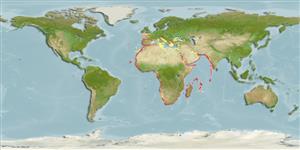Teleostei (teleosts) >
Eupercaria/misc (Various families in series Eupercaria) >
Sciaenidae (Drums or croakers)
Etymology: Umbrina: Latin, umbra, -ae = shadow, in the sense of phantom; due to its quick movements (Ref. 45335).
More on author: Valenciennes.
Environment: milieu / climate zone / depth range / distribution range
Ecology
Marine; demersal; depth range 50 - 300 m (Ref. 4780), usually 150 - 200 m (Ref. 26999). Subtropical; 50°N - 28°S
Eastern Atlantic: Bay of Biscay to South Africa (Ref. 4373), including the western Mediterranean. Western Indian Ocean: east coast of Africa (Ref. 3490); probably also in the Arabian Sea under synonyms capensis (non Pappe ?), sinuata Day and striata Boulenger.
Length at first maturity / Size / Weight / Age
Maturity: Lm 23.5 range ? - ? cm
Max length : 80.0 cm TL male/unsexed; (Ref. 30573); common length : 40.0 cm TL male/unsexed; (Ref. 3593); max. reported age: 27 years (Ref. 127644)
Found in mud and sandy bottoms of the shelf and upper slope (Ref. 4780), 14° to 15° C (Ref. 36731). Feed on small shrimps, worms and other bottom invertebrates (Ref. 4780). Sold fresh and dried salted (Ref. 3490).
Chao, L.N. and E. Trewavas, 1990. Sciaenidae. p. 813-826. In J.C. Quero, J.C. Hureau, C. Karrer, A. Post and L. Saldanha (eds.) Check-list of the fishes the eastern tropical Atlantic (CLOFETA). JNICT, Lisbon; SEI, Paris; and UNESCO, Paris. Vol. 2. (Ref. 3593)
IUCN Red List Status (Ref. 130435: Version 2024-1)
Threat to humans
Harmless
Human uses
Fisheries: commercial
Tools
Can't connect to MySQL database fbquizv2. Errorcode: Too many connections
